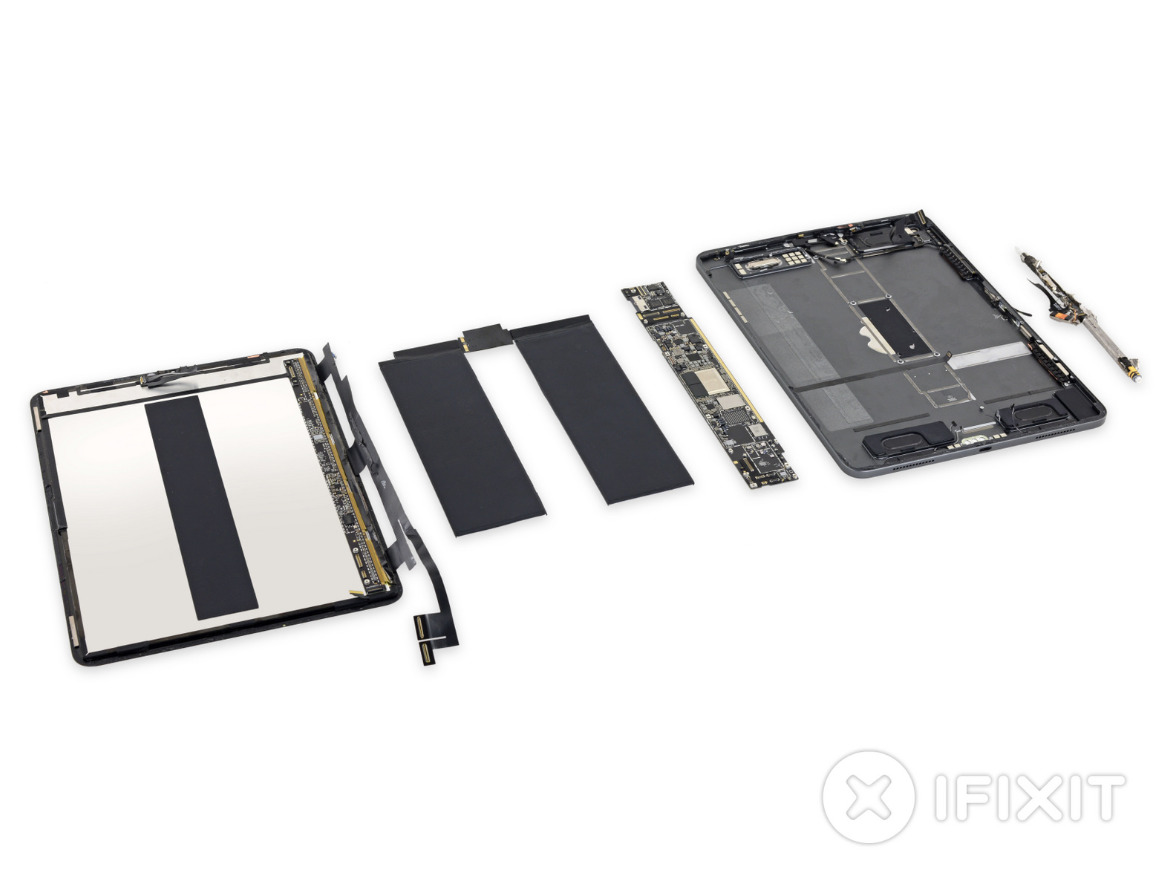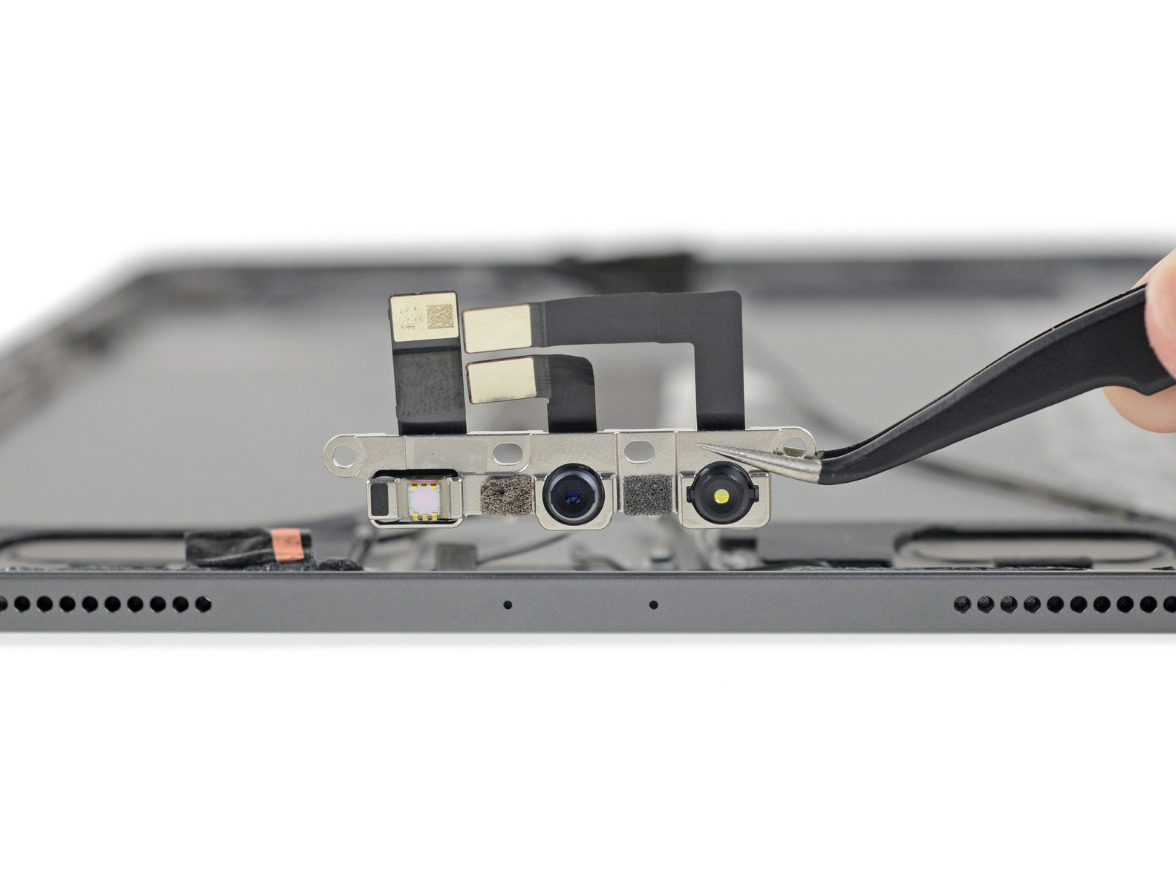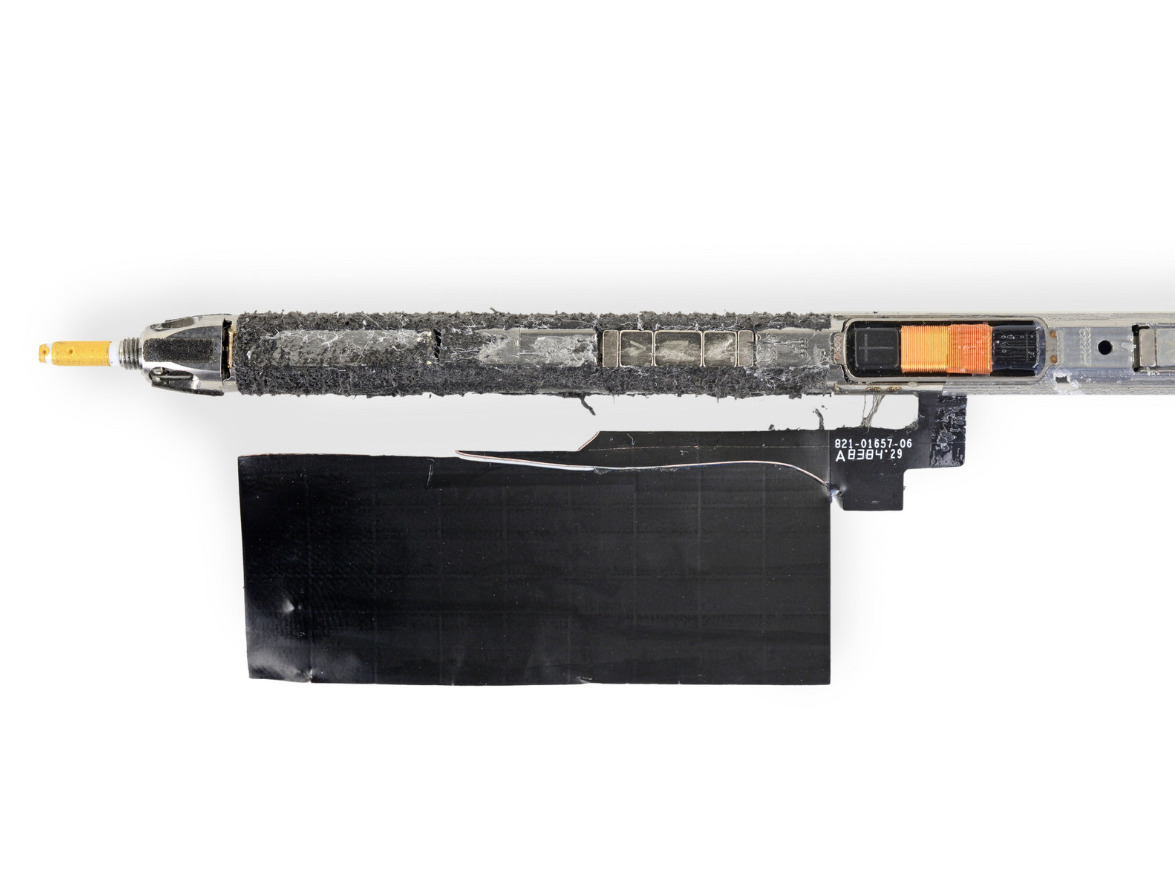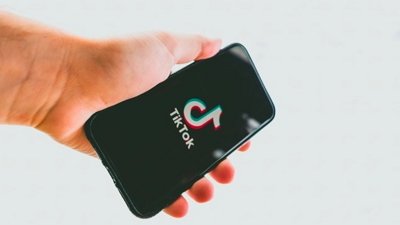Apple's 11-inch iPad Pro uses similar hardware to iPhones to offer Face ID, a teardown of the tablet reveals, while the accompanying updated Apple Pencil appears to have a capacitive grid embedded within its slim body, most likely used for the new tapping functionality.
The slimline 11-inch iPad Pro marked a major redesign of the tablet line to offer Face ID, a larger display with smaller bezels, and a slimline 5.9mm-thick chassis, making it the thinnest iPad or iPhone ever produced. While the device has many new elements, it seems that the difficult-to-repair nature of the device continues to be an issue for some users.
The customary teardown by iFixit noted the front display was held down by glue, with the thinner bezels said to make the deconstruction "a bit more harrowing than usual." While the display's ribbon cables are noted to be a safe distance from the bezels, they are also spread out in a way that makes the display removal a bit tougher, with the display needed to be laid at an angle to remove them.
Once inside, the first stand-out element was the construction of the speakers, which consists of four woofers and four tweeters, one for each corner. Pre-teardown x-rays of the iPad Pro clearly showed each of the speaker units in each of the corners, alongside a large number of magnets used to align accessories that attach to the rear, such as cases.
The Liquid Retina display, a scaled-up version of the one used on the iPhone XR, is observed to use Texas Instruments and Intersil chips, along with the same Parade Technologies timing controller used in the 10.5-inch iPad Pro.
The logic board is buried in between two battery cells, protected by a strip held down with adhesive. Along with the new Apple-designed A12X Bionic system-on-chip is Toshiba flash storage, Micron RAM, an NXP NFC controller, Apple's Wi-Fi and Bluetooth module, two Broadcom touch screen controllers, a Texas Instruments power controller, and a power management integrated circuit from STMicroelectronics.
This year's model uses stretch-release battery tabs, which makes it easier to extract the batteries, and are supplied with two tabs per strip just in case one is damaged. While the 7,812mAh battery is easier to remove than in previous models using the strips, there is still a notable patch of glue along one side that requires more intensive prying to free the unit.
The Face ID unit's TrueDepth camera array is similar in terms of components to the iPhone X and newer iPhone models, consisting of a normal camera, IR camera, and IR dot projector, but in a modified form factor. Unlike the iPhones, the iPad Pro can use Face ID at all angles, with the teardown suggesting this is probably just a software solution rather than using new hardware.
The Pencil charging board is removable, complete with copper charging coils for induction charging, but lost a number of capacitors in the process. Lastly, the new USB-C port is removed and is said to be fully modular, which will make it easier to remove and replace if worn out.
The 11-inch iPad Pro was issued a "repairability score" of three out of a possible 10, a marginal improvement on the 10.5-inch iPad Pro's score last year.
While the USB-C's modularity and the lack of a physical home button simplifying repairs are seen as positives, the use of conventional adhesive along with easier-to-remove stretch-release tabs was confusing, and the fused LCD and front glass panel is likely to increase the cost of repair due to being replaced as an entire unit rather than separately.
The teardown of the new Apple Pencil involved its destruction, due to a seeming lack of entry points, necessitating the use of an ultrasonic blade. Once taken apart, the Pencil is shown to contain a new wireless charging assembly, magnets, and a black sheath.
The sheath turns out to be a large black ribbon cable with what seems to be a capacitive grid. While it is believed to be used to operate the Apple Pencil's new tapping function, it is suggested the grid nature could be used to detect where on the Pencil the tapping takes place, and could even be used for more complex gestures.
An October patent application reveals Apple previously considered the use of another technology for tapping and other gestures. Using ultrasonic transducers along the shaft of the stylus, it would be feasible to determine where the user is gripping the Apple Pencil, as well as movements and taps on the body of the Pencil itself.
 Malcolm Owen
Malcolm Owen









-m.jpg)






 Wesley Hilliard
Wesley Hilliard
 Marko Zivkovic
Marko Zivkovic

 Christine McKee
Christine McKee
 Amber Neely
Amber Neely










4 Comments
I think it was pretty obvious that the pen can't be serviced just by looking at its design. I'm interested to see when they allow single and triple tap and if they introduce other gestures, since the capacitor looks pretty big. I'm still getting use to the double tap, I activate it accidentally too many time while drawing on the iPad.
Like most consumers, repairability isn't high on the list of attributes I'm looking for in a tablet. Size, weight, speed, easy of use come out on top. I can always get it serviced by the shop if I need a repair, which, going back to my original iPad 1 that still functions, I haven't.
This sucks for the 6 people that were planning on "repairing" their iPad Pros. For 99.999% of others, these repair scores are irrelevant.
I have iPad Pro 11 and Pencil and I use Apple's Cover (without keyboard) which is extremely well designed. I love them. I am always mystified how they manage to put complex circuit into Pencil since there's no entry points as pointed in the article. They must have been molded and polished to make it seamless. Honestly, the new iPad Pro and Pencil are WAY much better than my iPad Pro First Generation. It literally addresses every complaint I have with iPad Pro. Pencil finally gets the double tap for "erase" and it's all wireless recharging. I hated how awkward it was for Pencil to be inserted into iPad Pro. Now all that are eliminated. Less junk to deal with. No more extra cables. I use a single USB-C recharger for my MacBook Pro and also for my iPad Pro (it also works).